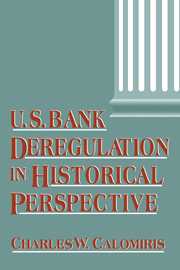Book contents
- Frontmatter
- Contents
- Acknowledgments
- Introduction
- 1 Regulation, industrial structure, and instability in U.S. banking: An historical perspective
- 2 The origins of banking panics: Models, facts, and bank regulation (with Gary Gorton)
- 3 The origins of federal deposit insurance (with Eugene N. White)
- 4 The costs of rejecting universal banking: American finance in the German mirror
- 5 The evolution of market structure, information, and spreads in American investment banking (with Daniel M. G. Raff)
- 6 Universal banking, “American style”
- General Index
- Index of Names
2 - The origins of banking panics: Models, facts, and bank regulation (with Gary Gorton)
Published online by Cambridge University Press: 11 September 2009
- Frontmatter
- Contents
- Acknowledgments
- Introduction
- 1 Regulation, industrial structure, and instability in U.S. banking: An historical perspective
- 2 The origins of banking panics: Models, facts, and bank regulation (with Gary Gorton)
- 3 The origins of federal deposit insurance (with Eugene N. White)
- 4 The costs of rejecting universal banking: American finance in the German mirror
- 5 The evolution of market structure, information, and spreads in American investment banking (with Daniel M. G. Raff)
- 6 Universal banking, “American style”
- General Index
- Index of Names
Summary
Introduction
The history of U.S. banking regulation can be written largely as a history of government and private responses to banking panics. Implicitly or explicitly, each regulatory response to a crisis presumed a “model” of the origins of banking panics. The development of private bank clearing houses, the founding of the Federal Reserve System, the creation of the Federal Deposit Insurance Corporation, the separation of commercial and investment banking by the Glass-Steagall Act, and laws governing branch banking all reflect beliefs about the factors that contribute to the instability of the banking system.
Deposit insurance and bank regulation were ultimately successful in preventing banking panics, but it has recently become apparent that this success was not without costs. The demise of the Federal Savings and Loan Insurance Corporation and state-sponsored thrift insurance funds and the declining competitiveness of U.S. commercial banks have had a profound effect on the debate over proper bank regulatory policy. Increasingly, regulators appear to be seeking to balance the benefits of banking stability against the apparent costs of bank regulation.
This changing focus has provided some of the impetus for the reevaluation of the history of banking crises to determine how banking stability can be achieved at a minimum cost. The important question is: What is the cause of banking panics? This question has been difficult to answer.
- Type
- Chapter
- Information
- U.S. Bank Deregulation in Historical Perspective , pp. 93 - 163Publisher: Cambridge University PressPrint publication year: 2000
- 8
- Cited by

